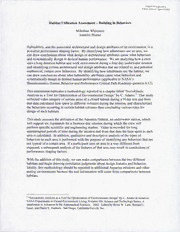
NASA Technical Reports Server (NTRS) 20110000649: Habitat Utilization Assessment - Building in Behaviors PDF
Preview NASA Technical Reports Server (NTRS) 20110000649: Habitat Utilization Assessment - Building in Behaviors
--- .---" I Source of Acquisition ASA lolmson Space Center Habitat Utilization Assessment - Building in Behaviors Mihriban Whitmore Jennifer Blume Habitability, and the associated architectural and design attributes of an environment, is a powerful performance shaping factor. By identifying how inhabitants use an area, we can draw conclusions about what design or architectural attributes cause what behaviors and systematically design in desired human performance. We are analyzing how a crew uses a long duration habitat and work environment during a four-day underwater mission and identifying certain architectural and design attributes that are related to, and potential enablers of, certain crew behaviors. By identifying how inhabitants use the habitat, we can draw conclusions about what habitability attributes cause what behaviors and systematically design in desired human performance (applicable to NASA's Bioastronautics Human Behavior and Performance Critical Path Roadmap question 6.12). This assessment replicates a methodology reported in a chapter titled "Sociokinetic Analysis as a Tool for Optimization of Environmental Design" by C. Adams.' That study collected video imagery of certain areas of a closed habitat during a 91 day test and from that data calculated time spent in different volumes during the mission, and characterized the behaviors occurring in certain habitat volumes thus concluding various rules for design of such habitats. This study assesses the utilization of the Aquarius Habitat, an underwater station, which will support six Aquanauts for a fourteen-day mission during which the crew will perform specific scientific and engineering studies. Video is recorded for long uninterrupted periods of time during the mission and from that data the time spent in each area is calculated. In addition, qualitative and descriptive analysis of the types of behaviors in each area is performed with the purpose of identifying any behaviors that are not typical of a certain area. If a participant uses an area in a way different from expected, a subsequent analysis of the features of that area may result in conclusions of performance shaping factors. With the addition of this study, we can make comparisons between the two different habitats and begin drawing correlation judgments about design features and behavior. Ideally, this methodology should be repeated in additional Aquarius missions and other analog environments because the real information will come from comparisons between habitats. I "Sociokinetic Analysis as a Tool for Optimization of Environmental Design" by C. Adams in Isolation: NASA Experiments in Closed-Environment Living. Volume 104 Science and Technology Series, A supplement to Advances in the Astronautical Sciences. 2002. Edited by Helen W. Lane, Richard L. Sauer, and Daniel L. Feeback. San Diego, California:Univelt, Inc. -----_._---
